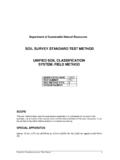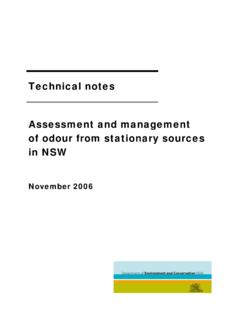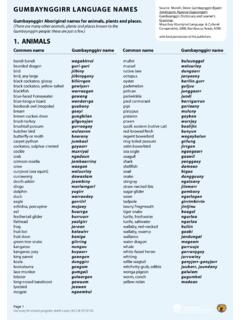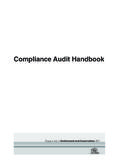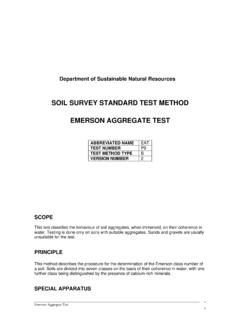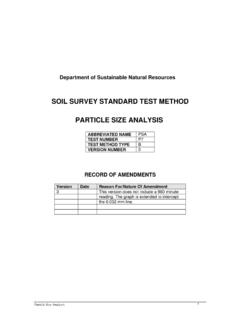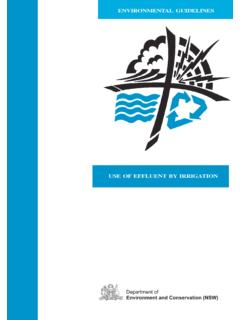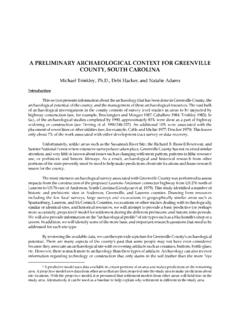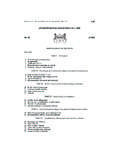Transcription of HOW TO PREPARE ARCHIVAL RECORDS OF HERITAGE ITEMS
1 HERITAGE INFORMATION SERIES HOW TO PREPARE ARCHIVAL RECORDS OF HERITAGE ITEMS ACKNOWLEDGMENT This document is partially based on a draft publication, Recording Places of Cultural Significance (1991), prepared for the Department of Planning by Meredith Walker & Associates with the financial support of the HERITAGE Assistance Program. DISCLAIMER Any representation, statement, opinion or advice, expressed or implied in this publication is made in good faith but on the basis that the State of New South Wales, its agents and employees are not liable (whether by reason of negligence, lack of care or otherwise) to any person for any damage or loss whatsoever which has occurred or may occur in relation to that person taking or not taking (as the case may be) action in respect of any representation, statement or advice referred to above.
2 NSW HERITAGE Office Locked Bag 5020 Parramatta NSW 2124 Ph: (02) 9873 8500 Fax: (02) 9873 8599 Crown copyright 1998 3rd edition This edition first published June 1998 ISBN 1 876415 08 8 HO98/19 Front cover graphics: Aboriginal hand stencils, South Coast. Photograph courtesy of National Parks and Wildlife Service Interior of Belltrees shearing shed, built near Scone in NSW in 1879 by architect J. Horbury Hunt. Artefacts from the site of first Government House Archaeology Collection. Photograph courtesy of Museum of Sydney on the site of first Government House Grose Valley, Blue Mountains, NSW. Photograph courtesy of NSW National Parks and Wildlife Service Back cover graphics: Australia Square, Sydney Entrance to the central temple, Sze Yup Temple, Glebe. Photograph by Karl Zhao Lands Department Building, Sydney The bow of iron steamer, Merimbula, wrecked near Currarong in 1928.
3 Photograph by David Nutley Snowy Mountains Scheme. Photograph courtesy of the Snowy Mountains Hydro-electric Authority St Mark s Anglican Church, Darling Point, Sydney. Photograph by Stuart Humphreys Belltrees Shearing Shed, near Scone, NSW. Detail from the crypt floor of St Mary s Cathedral, Sydney. Photograph courtesy of St Mary s Cathedral CONTENTS PAGE 1. INTRODUCTION 1 2. WHEN ARE RECORDS PREPARED? 1 3. WHO WILL USE THE ARCHIVAL RECORD? 2 4. WHAT TYPE OF RECORD IS APPROPRIATE? 3 5. PREPARING THE ARCHIVAL RECORD YOURSELF 3 6. HOW TO ENGAGE A CONSULTANT TO PREPARE AN ARCHIVAL RECORD 4 7.
4 PREPARATION FOR ARCHIVAL RECORDING 5 8. TYPES OF ARCHIVAL RECORDINGS 8 9. COLLATING AND STORING THE ARCHIVAL RECORD 13 10. USEFUL REFERENCES 15 11. MINIMUM REQUIREMENTS FOR ARCHIVAL RECORDING 17 SCHEDULES A. ITEMS OF LOCAL HERITAGE SIGNIFICANCE 17 B. ITEMS OF REGIONAL HERITAGE SIGNIFICANCE 18 C. ITEMS OF STATE HERITAGE SIGNIFICANCE 19 D. ITEMS INVOLVING HISTORICAL archaeological EVIDENCE 20 E. ITEMS INVOLVING INDUSTRIAL archaeological EVIDENCE 21 F. ITEMS INVOLVING UNDERWATER archaeological EVIDENCE 22 G. ITEMS INVOLVING EVIDENCE OF SIGNIFICANT SOCIAL CUSTOMS 23 H.
5 ITEMS INVOLVING SIGNIFICANT CULTURAL LANDSCAPES 24 EXAMPLES OF ARCHIVAL RECORDS 1 INTRODUCTION HERITAGE ITEMS can be landscapes, places, works, buildings, movable objects or relics of architectural, archaeological , aesthetic, social, cultural, technical, scientific or natural HERITAGE significance. ARCHIVAL RECORDS are made of HERITAGE ITEMS as a way of contributing to our understanding and appreciation of our culture. They record for the future the environment, aesthetics, technical skills and customs associated with the creation and use of HERITAGE ITEMS before they are lost, either by progressive changes or the ravages of time. These guidelines provide an outline of some of the issues related to HERITAGE recording. For more details refer to the publications listed in Section 10 of this document.
6 For information on recording ITEMS of Aboriginal or natural HERITAGE significance contact the National Parks and Wildlife Service. 2 WHEN ARE RECORDS PREPARED? RECORDS are usually prepared: when establishing the HERITAGE significance of the item; before making decisions on the management of the item ( when preparing a conservation plan); when developing or carrying out a maintenance and monitoring program for the item ( for annual maintenance inspections); before and during work to the item ( alterations and additions); before full or partial demolition of the item or relocation of objects or collections; before and during archaeological investigations. If you propose to carry out work on a HERITAGE item, one of your first steps should be to research existing ARCHIVAL material on the item and to create a new ARCHIVAL record of the item in its current state.
7 The record will add to your understanding of the HERITAGE item and its significance as part of the conservation and management process. Sometimes ARCHIVAL RECORDS are required by authorities such as local councils or the HERITAGE Council as part of a conditional approval for work to be carried out on a HERITAGE item. The amount and type of record required will usually depend on the degree of significance of the item. 2 Emergency Recording In some cases, especially where a life-threatening situation has arisen, there may be little time available to carry out a thorough recording process. An emergency black-and-white photographic record of the item should be made. Make sure that the photographer can do the work with the permission of the item's owner or occupier and without risk to life and limb.
8 In the case of a movable item its context should also be recorded on a site plan or floor plan as well as its historic association with a person and place. Even in these special circumstances it is important that a schedule of the subject and location of each photographic frame is also drawn up (see Section 8 of these guidelines). The photographic record should also be collated with any other ARCHIVAL material on the item, using the process described in Section 9. 3 WHO WILL USE THE ARCHIVAL RECORD? ARCHIVAL RECORDS of HERITAGE ITEMS are consulted by people who need information on the culture of previous generations. They include: HERITAGE professionals researching the history of an organisation, place, object or community; interested members of the general public researching the history of their ancestors or local area; in the case of movable HERITAGE ITEMS , HERITAGE professionals or a community wanting to reinstate ITEMS in a HERITAGE place or return them to a person or community.
9 The researcher will be interested not just in the physical appearance of the HERITAGE item at the time of the recording, but also in: evidence of changes in the item over time revealed by its fabric; a sense of the scale of internal and external spaces; evidence of significant finishes and furnishings; evidence of how the item was used by owners or occupiers; information on relationships to people and place and history of ownership; and evidence of floor plans, site plans and spatial relationships. 34 WHAT TYPE OF RECORD IS APPROPRIATE? The ARCHIVAL record will vary according to the type of HERITAGE item and the reasons for its preparation. For example, the record for an historic shipwreck will differ in type and technique from that for a cultural landscape.
10 A photographic record which refers back to base plans for the location of the photograph will always be necessary. In some cases this may be a sufficient level of recording. In other cases a combination of drawings and photographs can be considered. For very significant ITEMS or structures, or ITEMS which include rare design or construction details, measured technical drawings will usually be required. If a place demonstrates a rare industrial or social process you should consider carrying out a film or video recording, preferably while the site is in use. A written and/or diagrammatic description of the processes should be a minimum requirement for the recording of these complex sites. Oral histories of people who have been associated with the HERITAGE item are a valuable way of recording social and industrial history.

